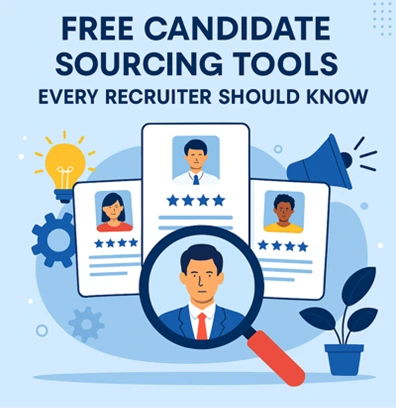
Recruiting has never been easy. Some days you feel like you're swimming in resumes, and other days it feels like the perfect candidates just don't exist. On top of that, premium job portals and recruiter tools are getting costlier every year. Not every HR team, especially in small and mid-sized companies, can afford them.
The reality is this: good recruiters don't just rely on paid tools. They know where to look, how to connect, and how to make the most of what's already available for free. Over the past few years, I've seen recruiters (myself included) close some of the toughest roles using nothing but free sourcing platforms.
So, if you've been stretching your budget or waiting endlessly on job postings, here's some good news. There are plenty of free tools that can help you find strong candidates and speed up your hiring process.
Some might argue—"Why not just pay for LinkedIn Recruiter or a premium ATS and save time?" Fair question. But here's why free tools are worth your time:
I've seen recruiters fill niche positions without spending a single rupee on subscriptions—just by being smart about where they source.

LinkedIn needs no introduction. Even without a premium plan, it's powerful if you know how to use it well.
You can:
👉 Pro tip from my desk: Never send the plain "We are hiring, share your CV" message. Instead, reference something from their profile. For example: "Hi Ramesh, I noticed your experience with supply chain analytics. We have a role where your background fits well. Can I share details?"
That small personalization changes everything.
Most recruiters underestimate Google. The truth is—it's one of the most powerful free sourcing tools out there if you use Boolean searches.
Try this:
(site:github.com OR site:behance.net) AND ("UI Designer" OR "UX Designer") AND (Chennai OR Bangalore)
This will give you real profiles—designers on Behance or developers on GitHub.
I've personally found hidden gems through this method. It feels like detective work, but it works wonders for niche roles.
When you're hiring for IT roles, job boards don't always show you skill depth. GitHub and Stack Overflow do.
On GitHub, you can actually see a candidate's code, projects, and contributions.
On Stack Overflow, you see who is solving problems for others. That's skill + passion.
A colleague once found a backend developer by spotting his Stack Overflow answers. The candidate wasn't even actively job hunting, but he was open to discussions when approached the right way.
If your company is in the startup ecosystem, AngelList (now called Wellfound) is a must-check. The profiles here are often startup-friendly, flexible, and open to experimenting with growth roles.
It's free to browse, and many candidates are already mentally tuned to dynamic environments.
This might surprise some, but I've seen roles get closed faster through a local WhatsApp job group than on a big job portal.
Industry-specific Facebook groups and WhatsApp job circles are buzzing with activity, especially in India. Candidates there respond quickly and also share openings with friends.
Tip: Instead of long text ads, create a simple job poster (even on Canva) and share it. Posts with visuals grab more attention in groups.

Indeed allows a limited number of resume searches for free. It may not be enough for bulk hiring, but for a one-off urgent role, it works well.
Use filters smartly—narrow by skill, location, and years of experience so you don't waste your free quota.
This is one of my favorites for spotting engaged candidates. People who attend meetups are already investing time in improving themselves.
For example, a recruiter I know sourced data scientists by attending a local AI meetup. She didn't pitch jobs directly, but built connections first, which later led to smooth hires.
That's the difference—on Meetup, you're not just finding candidates, you're finding motivated learners.
Sourcing isn't just about finding—it's also about attracting. Canva makes this easy. Even if you don't have a design team, you can create job banners in minutes and post them across LinkedIn, Instagram, or WhatsApp.
One creative job post often gets reshared by multiple people, multiplying reach for free.
Glassdoor isn't only for company reviews. Many candidates keep their profiles updated there. Similarly, Jobcase is a community-driven platform with strong blue-collar and mid-skill candidate pools.
Both can be explored without spending money.
I saved the best for last. Your employee and LinkedIn network referrals are the most reliable free sourcing channel.
If your employees enjoy working at your company, they'll gladly refer others—even without a monetary reward. Recognition on LinkedIn, or even a simple thank-you, often goes a long way.
Finding profiles is step one. The real game is engaging candidates properly. From my experience:
Free tools work best when you're consistent. Candidates remember recruiters who don't just pop up only when they need something.
Recruiting isn't about the size of your budget—it's about the creativity and persistence you bring to the table. Free tools like LinkedIn, Google Boolean searches, GitHub, AngelList, and even WhatsApp groups can help you source high-quality candidates at zero cost.
The trick is knowing how to use them strategically and building real human connections.
So next time you're about to buy a premium subscription, try these free methods first. You might be surprised at how effective they are.
Share your thoughts—I'd love to hear how other recruiters are making the most of free sourcing tools.